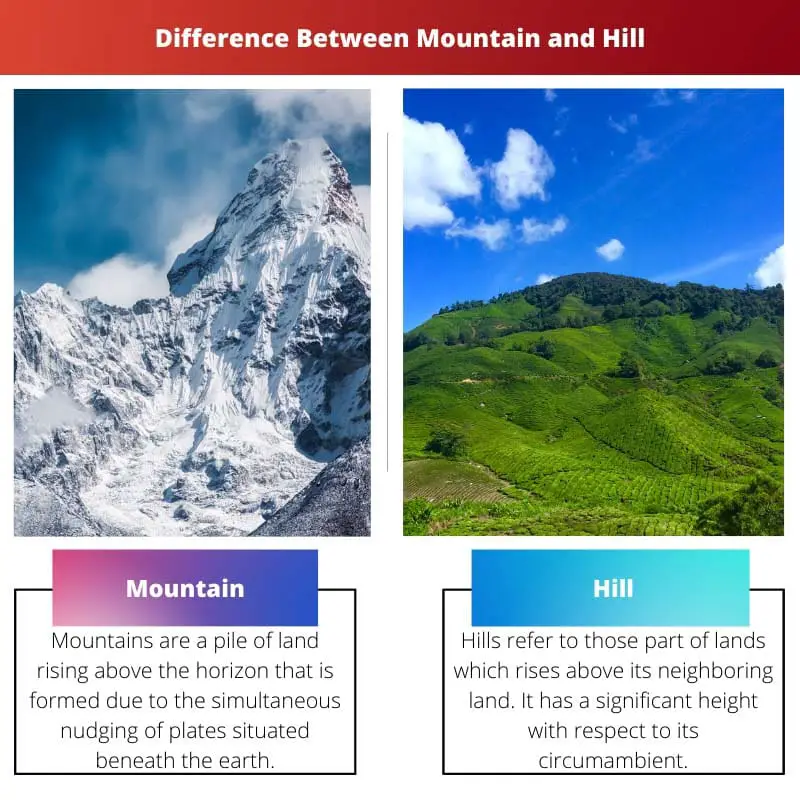Mountains and hills are geographical features that determine the topography of physical land. They hold no official classification that can distinguish them. The U. S. Board initially considered hills to have summits of less than 1000 feet. The statement was abolished in the 1970s. They are categorized as generic terms that lack significant characteristics.
Key Takeaways
- Mountains have steeper slopes and higher elevations, exceeding 2,000 feet above sea level.
- Hills are lower in elevation, with gentler slopes and more rounded contours.
- Both landforms provide unique ecosystems, recreational opportunities, and geological features.
Mountain vs Hill
Mountains are parts of land that have high altitudes. Mountains have steep slopes. Climate is also affected by mountains. The height of mountains can be higher than 2000 feet. A hill is a higher part of land. Hills have low altitude as compared to mountains. The height of hill cannot be more than 2000 feet.

Mountains are a pile of land rising above the horizon that is formed due to the simultaneous nudging of plates situated beneath the earth. Continuous eruptions result in the formation of those higher and steeper peaks. The formation of the spectacular Himalayas is the result of such erosion that was initiated 55 million years before.
Hills refer to parts of the land that rise above their neighbouring land. It has a significant height with respect to its circumambient. Hills are not as steep as mountains. Hills have a distinct summit. Accumulation of sediment and rock soil results in the formation of hills. Likewise, hills get eroded due to certain geological occurrences.
Comparison Table
| Parameters of Comparison | Mountain | Hill |
|---|---|---|
| Altitude | High | low |
| Nomenclature | Mountains are assigned with names. | Hills are unnamed. |
| Occurrence | Faulting results in the formation of a mountain. | Hills are formed by erosion. |
| Slope | The slope of the mountains is steep. | The slope of hills is less steep than those of the mountains. |
| Heights | The mountains are more than 2000 feet. | Natural hills are lesser than 2000 feet. |
What is Mountain?
Mountains are chunks of land that rise above the land surface throughout the earth, including oceans. Mountains are steeper than hills. They have erect slopes with high altitudes. Geologists say a mountain must be more than a thousand feet from sea level. A series of mountains with no distinct space between them forms a mountain range.
These massive mountain ranges are formed when the plates inside the earth’s crust interact, resulting in plate tectonics. They pile up, forming a huge bump on the earth’s surface. The Himalayas are the result of such interaction that was initiated fifty-five million ago. The apex of Mount Everest is the highest peak on earth.
Mauna Kea is the tallest mountain but is 4,205 meters high from sea level. Otherwise, it is as tall as 10,203 meters. Mountains can be classified into the following types. They are as follows, with corresponding examples.
- Volcanic mountains (Mount St. Helens and Mount Fuji)
- Dome mountains (the Adirondack Mountains, black mountains)
- Fault block mountains (the Sierra Nevada, Harz Mountains)
Mountains have impacts on territories. Their massive boundaries serve the purpose of borders. They have an influence on the climate, including storms swaying through the ocean to rain pouring from the clouds. Mountains provide shelter to fugitives.

What is Hill?
A hill denotes a section of land that is on a higher level with respect to its neighbouring surfaces. Hill is a cluster of land that resembles a lump in your body. One can expect a better view of the surroundings standing on the hill. Hills are not difficult to climb. The earth’s surface is full of hills, frequently resulting due to natural erosion.
Hills are less steeper in contrast to mountains. People can climb them with ease. Besides mountains, hills have summits, which are their apex. Hills are not pointed as mountains, rather they are blunt. History shows ancient people sculpted hills, and they were named mounds. One such community is Hopewell. The mounds were 305 meters wide with a height of 9 meters. Archaeologists are unaware of the purpose of the mounds.
On the other hand, the natural occurrence of hills is caused by the spontaneous nudging of the plates underneath the earth’s layer. Hills occurring via natural causes can turn into mountains through further erosion. The plates are constantly vibrating, resulting in changes in topography.
A hill can be roughly classified into three categories. They are
- A drumlin (resulting due to movement of the glaciers)
- A butte ( an entire area having one hill)
- A tor (formation of rock on a hilltop)

Main Differences Between Mountain and Hill
- Mountains have steeper slopes, whereas hills are not so steep.
- Mountains are challenging to climb, whereas most of the hills can be climbed with ease.
- Mountains are identified with specific names, whereas hills are not named often.
- Mountains have higher altitudes, while hills have lower altitudes.
- Faulting is the cause behind the formation of mountains, whereas erosion leads to the formation of hills.

- https://www.sciencedirect.com/science/article/pii/S0378112710000782
- https://link.springer.com/article/10.1007/s11434-013-5847-6

This article is very academic and provides a scientific analysis of mountains and hills.
The article doesn’t offer anything new; it’s just recycling established information.
I have to disagree; it addresses various aspects of mountain and hill classification.
I personally found the details quite fascinating.
The comparison between mountains and hills is quite enlightening. Thanks for this!
Absolutely, this cleared up a lot of confusion for me.
I appreciate the scientific references used throughout the article.
I particularly liked the use of the scientific sources, very well done.
Yes, the citations add credibility to the content.
The article presents the differences between mountains and hills in a compelling manner. Very well done.
I find the information in this article very insightful.
I love how the article describes all the types of mountains and hills. It’s so informative and interesting!
Yes, it’s a very detailed and well-researched article.
Couldn’t agree more. Great content!
The article is so engaging and addresses the subject thoroughly!
Definitely! An excellent piece of literature.
Agreed! I’m impressed with the depth of information.